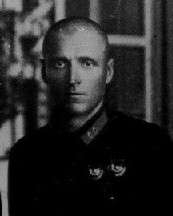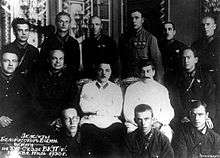Maxim Stepanov
| Maxim Stepanov | |
|---|---|
 | |
| Born |
August 1893 Russian Empire |
| Died |
25 September 1945 (aged 52) Kotlas, Soviet Union |
| Allegiance |
Russian Empire Soviet Union |
| Service/ |
Imperial Russian Army Soviet Red Army |
| Years of service |
1915–1917 (Russian Empire) 1918–1938 (Soviet Union) |
| Battles/wars |
World War I Russian Civil War |
Maxim Osipovich Stepanov (August 1893 – 25 September 1945) was a Soviet komkor (corps commander). He fought for the Imperial Russian Army in World War I before going over to the Bolsheviks during the subsequent civil war. He received the Order of the Red Banner twice (1920, 1922). During the Great Purge, Stepanov's colleague division commissar Peter Maximovich Feldman (standing to his left in the group photo behind Alexander Yegorov) was executed on August 22, 1938. On November 28, 1938, the Central Committee of the Communist Party of the Soviet Union made the decision to dismiss Stepanov from the military, which was carried out the next day. He was arrested on December 9, 1938. He initially pleaded guilty to the charges he was accused of, but then withdrew his plea. He was convicted on May 31, 1939 and sentenced to 20 years imprisonment. He survived the Great Patriotic War, but did not participate in it. He died shortly after the end of the Soviet–Japanese War of 1945 in a prison camp in Arkhangelsk Oblast. After the death of Joseph Stalin, he was posthumously rehabilitated on June 30, 1956.
Interwar period

He attended the 16th Congress of the All-Union Communist Party (Bolsheviks) from 26 June to 13 July 1930. On 26 November 1935, he was promoted to Komdiv when the Red Army introduced personal military ranks.[1] Stepanov was promoted to Komkor on 22 February 1938.
Arrest and imprisonment
Stepanov was arrested on 9 December 1938, and sentenced to twenty years of imprisonment in the gulag on 31 May 1939, charged with participating in a military conspiracy.[2] According to an account by historian Michael Parrish, on 30 March 1939, Stepanov wrote a letter to Kliment Voroshilov in which he told him that between 40to 45 percent of chemical officers serving in military districts and 60 to 65 percent of those with corps and divisions had been arrested in the Great Purge. Voroshilov forwarded the letter to the Special Department, and Stepanov was arrested.[3]
While in the gulag, Stepanov repeatedly wrote requests to various institutions requesting review of his case, but was turned down each time. Both of his sons, Boris and Vladimir, fought in combat during World War II, and during the war Stepanov himself requested to be sent to the front, even as a private, but was again denied. He died at the Intalag on 25 September 1945, and was posthumously rehabilitated on 30 June 1956.[2][4]
References
Citations
- ↑ "Приказы НКО по личному составу армии "О присвоении персональных военных званий начсоставу РККА" № 2484" [Order No. 2484 of the People's Commissar for Defense on conferring personal military ranks on command personnel]. rkka.ru (in Russian). 26 November 1935.
- 1 2 Cherushev & Cherushev 2012, pp. 109–110.
- ↑ Parrish 1996, p. 38.
- ↑ Cherushev 2003, pp. 260–269.
Bibliography
- Cherushev, Nikolai Semyonovich (2003). Удар по своим. Красная Армия: 1938—1941 [Under attack: The Red Army, 1938–1941] (in Russian). Moscow: Veche. ISBN 5-94538-366-X.
- Cherushev, Nikolai Semyonovich; Cherushev, Yury Nikolaevich (2012). Расстрелянная элита РККА (командармы 1-го и 2-го рангов, комкоры, комдивы и им равные): 1937—1941. Биографический словарь [Executed Elite of the Red Army (Komandarms of the 1st and 2nd ranks, Komkors, Komdivs, and equivalents) 1937–1941 Biographical Dictionary] (in Russian). Moscow: Kuchkovo Pole. ISBN 9785995002178.
- Parrish, Michael (1996). The Lesser Terror: Soviet State Security, 1939–1953. Praeger Press. ISBN 978-0-275-95113-9.